Hyundai i10 vs Toyota Prius – Which one offers the better deal?
Two cars, one duel: Hyundai i10 meets Toyota Prius.
Which one wins in performance, efficiency and value for money? Find out now!
Costs and Efficiency:
Looking at overall running costs, both models reveal some interesting differences in everyday economy.
Hyundai i10 has a convincingly advantage in terms of price – it starts at 14600 £, while the Toyota Prius costs 39400 £. That’s a price difference of around 24858 £.
Fuel consumption also shows a difference: Toyota Prius manages with 0.50 L and is therefore convincingly more efficient than the Hyundai i10 with 4.90 L. The difference is about 4.40 L per 100 km.
Engine and Performance:
Power, torque and acceleration are the classic benchmarks for car enthusiasts – and here, some clear differences start to show.
When it comes to engine power, the Toyota Prius has a convincingly edge – offering 223 HP compared to 90 HP. That’s roughly 133 HP more horsepower.
In acceleration from 0 to 100 km/h, the Toyota Prius is convincingly quicker – completing the sprint in 6.80 s, while the Hyundai i10 takes 11.40 s. That’s about 4.60 s faster.
In terms of top speed, the Toyota Prius performs minimal better – reaching 177 km/h, while the Hyundai i10 tops out at 175 km/h. The difference is around 2 km/h.
Space and Everyday Use:
Beyond pure performance, interior space and usability matter most in daily life. This is where you see which car is more practical and versatile.
Both vehicles offer seating for 5 people.
In curb weight, Hyundai i10 is clearly lighter – 996 kg compared to 1620 kg. The difference is around 624 kg.
In terms of boot space, the Toyota Prius offers slightly more room – 284 L compared to 252 L. That’s a difference of about 32 L.
When it comes to payload, Hyundai i10 to a small extent takes the win – 423 kg compared to 375 kg. That’s a difference of about 48 kg.
Who comes out on top?
Overall, the Toyota Prius shows itself to be outperforms in nearly all aspects and secures the title of DriveDuel Champion.
It convinces with the more balanced overall package and proves to be the more versatile choice for everyday use.
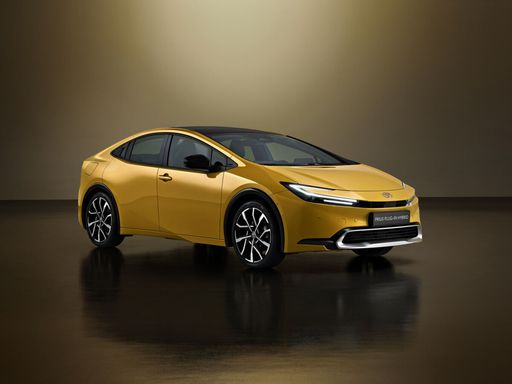 @ Toyota Motor Corporation
@ Toyota Motor Corporation
Toyota Prius
Hyundai i10
The Hyundai i10 is a cheeky city car that squeezes big-car confidence into a pocket-friendly package, carving through tight streets with surprising composure and sensible practicality. For buyers after low fuss, sensible equipment and wallet-friendly running costs, it's a smart, no-nonsense pick that makes sense whether you're a first-time driver or need a reliable second car.
details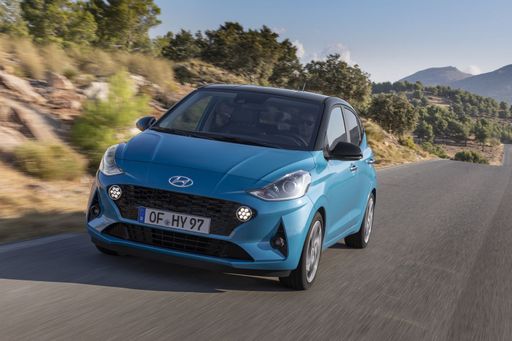 @ Hyundai Motor Company
@ Hyundai Motor Company
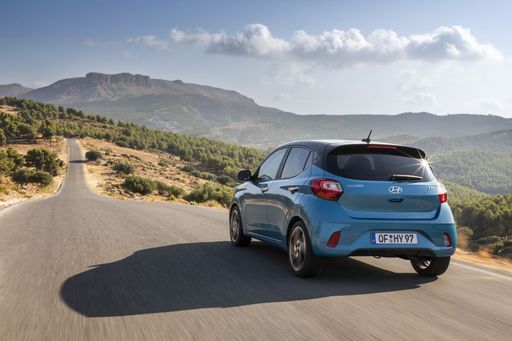 @ Hyundai Motor Company
@ Hyundai Motor Company
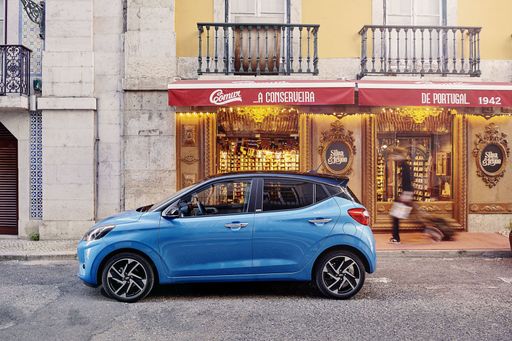 @ Hyundai Motor Company
@ Hyundai Motor Company
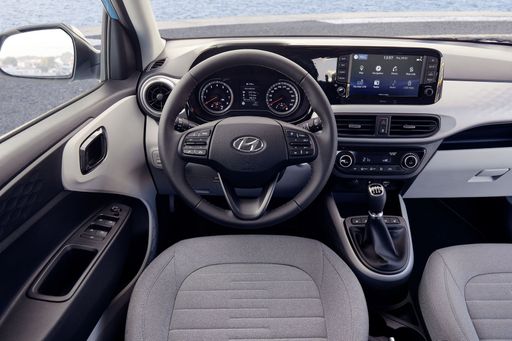 @ Hyundai Motor Company
@ Hyundai Motor Company
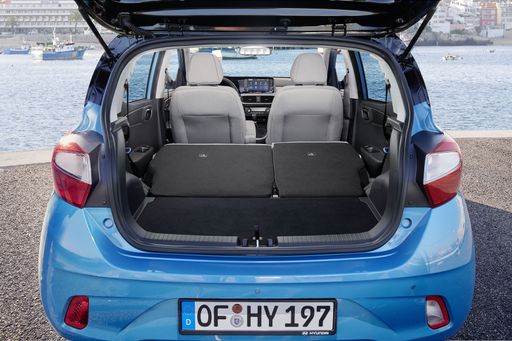 @ Hyundai Motor Company
@ Hyundai Motor Company
Toyota Prius
The Toyota Prius stands as a pioneer in the realm of hybrid vehicles, offering an eco-friendly driving alternative with its innovative technology. Its aerodynamic design and comfortable interior make it a practical choice for those looking to reduce their carbon footprint without sacrificing style. Additionally, the Prius boasts a reputation for reliability and efficiency, contributing to its lasting popularity among environmentally conscious drivers.
details @ Toyota Motor Corporation
@ Toyota Motor Corporation
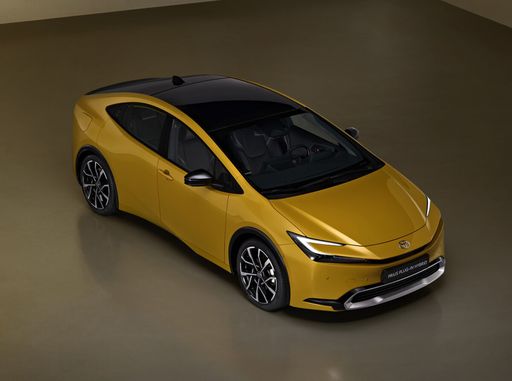 @ Toyota Motor Corporation
@ Toyota Motor Corporation
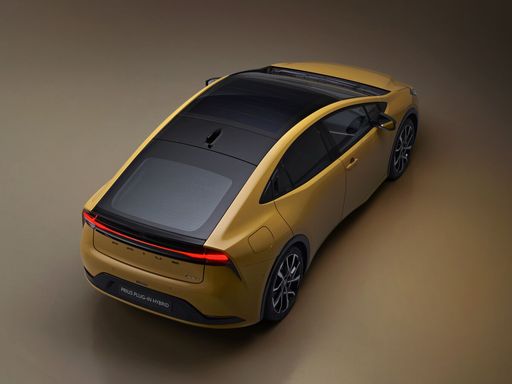 @ Toyota Motor Corporation
@ Toyota Motor Corporation
 @ Toyota Motor Corporation
@ Toyota Motor Corporation
 @ Hyundai Motor Company
@ Hyundai Motor Company
|
 @ Toyota Motor Corporation
@ Toyota Motor Corporation
|
|
|
|
Costs and Consumption |
|
|---|---|
|
Price
14600 - 19000 £
|
Price
39400 - 45800 £
|
|
Consumption L/100km
4.9 - 5.5 L
|
Consumption L/100km
0.5 - 0.7 L
|
|
Consumption kWh/100km
-
|
Consumption kWh/100km
-
|
|
Electric Range
-
|
Electric Range
72 - 86 km
|
|
Battery Capacity
-
|
Battery Capacity
-
|
|
co2
110 - 124 g/km
|
co2
12 - 17 g/km
|
|
Fuel tank capacity
36 L
|
Fuel tank capacity
40 L
|
Dimensions and Body |
|
|---|---|
|
Body Type
Hatchback
|
Body Type
Hatchback
|
|
Seats
4 - 5
|
Seats
5
|
|
Doors
5
|
Doors
5
|
|
Curb weight
996 - 1099 kg
|
Curb weight
1620 - 1630 kg
|
|
Trunk capacity
252 L
|
Trunk capacity
284 L
|
|
Length
3670 - 3675 mm
|
Length
4599 mm
|
|
Width
1680 mm
|
Width
1782 mm
|
|
Height
1480 - 1483 mm
|
Height
1470 mm
|
|
Max trunk capacity
1050 L
|
Max trunk capacity
-
|
|
Payload
344 - 423 kg
|
Payload
365 - 375 kg
|
Engine and Performance |
|
|---|---|
|
Engine Type
Petrol
|
Engine Type
Plugin Hybrid
|
|
Transmission
Manuel, Automatic
|
Transmission
Automatic
|
|
Transmission Detail
Manual Gearbox, Automated Manual
|
Transmission Detail
CVT
|
|
Drive Type
Front-Wheel Drive
|
Drive Type
Front-Wheel Drive
|
|
Power HP
63 - 90 HP
|
Power HP
223 HP
|
|
Acceleration 0-100km/h
11.4 - 18.4 s
|
Acceleration 0-100km/h
6.80 s
|
|
Max Speed
143 - 175 km/h
|
Max Speed
177 km/h
|
|
Torque
93 - 172 Nm
|
Torque
-
|
|
Number of Cylinders
3 - 4
|
Number of Cylinders
4
|
|
Power kW
46 - 66 kW
|
Power kW
164 kW
|
|
Engine capacity
998 - 1197 cm3
|
Engine capacity
1998 cm3
|
General |
|
|---|---|
|
Model Year
2024
|
Model Year
2023
|
|
CO2 Efficiency Class
C, D
|
CO2 Efficiency Class
B
|
|
Brand
Hyundai
|
Brand
Toyota
|
Is the Hyundai i10 offered with different drivetrains?
The Hyundai i10 is offered with Front-Wheel Drive.
The prices and data displayed are estimates based on German list prices and may vary by country. This information is not legally binding.
